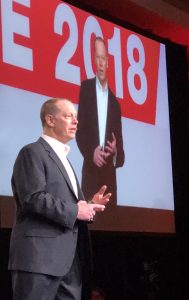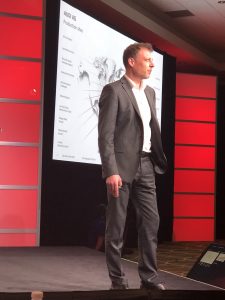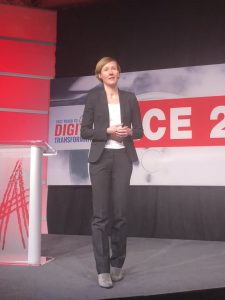
An Indy car on display at the ACE 2018 conference in Indianapolis, Indiana.
March 30, 2018
When the first cars raced at the Indianapolis Motor Speedway in 1909, the average cost of a new car was $1,280 and the transistor was decades away from being invented. Now the average price for a light vehicle in the U.S. is $36,270, which includes dozens of CPUs and what amounts to a rolling computer network tucked among thousands of mechanical parts in an attempt to satisfy our safety, infotainment and — of course — driving needs.
 An Indy car on display at the ACE 2018 conference in Indianapolis, Indiana.
An Indy car on display at the ACE 2018 conference in Indianapolis, Indiana.With the history of racing as the backdrop and the unprecedented speed of technical innovation threatening to disrupt the automotive and many other industries in the near future, Aras Corp. hosted its annual ACE Users Conference last week in Indianapolis. The company markets its Aras PLM Platform as an “open, flexible, scalable, and upgradable.” Those four features are key to helping companies capitalize on digital transformation.
The automotive industry certainly isn’t alone in dealing with digital disruption in the face of increased product complexity, but it is facing the perfect storm. Car makers are already offering increasingly sophisticated driver assistance, which is expected to lead to fully autonomous vehicles — many of which won’t even be owned by customers. So, in addition to offering new electric powertrains and integrating an unprecedented level of electronics that will soon be dwarfed by the incredible complexity required for autonomous driving, the industry is also expanding into the business of fleet management and maintenance.
 Aras CEO Peter Schroer
Aras CEO Peter SchroerDigital transformation technologies and processes — such as digital twins, a connected digital thread and the model-based enterprise — are expected to help the auto industry meet the challenges of disruption. But when?
“When we talk about digital twin, digital thread, most of you have a problem,” Aras CEO Peter Schroer told the 400+ attendees of ACE 2018 Aras user conference. “You’re not quite ready yet. When Excel is the primary database in the company, that’s a problem. We cannot build a digital thread through Excel. A PDF is not a digital data source.”
To help get the Aras community ready for digital transformation, Schroer said the company accepted a $40 million investment from Silver Lake and GE Ventures in September. He said the company’s commitment to being an open platform with apps on top hasn’t changed. The investment is being used to increase Aras’ global footprint, staff and breadth of applications — including the acquisition of the Impresa maintenance, repair, and overhaul (MRO) business from Infospectrum earlier this year.
“In order to do digital twin … you have to know about configuration changes,” said Schroer. “To do that you have to be in the repair depots. That’s what has us excited about the Impresa product. It puts us right into the operating system of the repair depot.”
Dirk Spindler, SVP, Application Engineering, R&D Industrial at Schaeffler: The product development processes didn’t keep up with the complexity of products. Schaeffler is building an Engineering Cockpit using #Aras to help it go digital. #aceconx pic.twitter.com/EMwg0MWwz5
— Digital Engineering (@DEeditor) March 20, 2018
Schroer said Aras also plans to expand into simulation process and data management. What we need to do is mainstream simulation, bring it into the full design and manufacturing process,” he said. “And now with the MRO I’ve got the digital twin data, how do we enable simulation of the actual configuration that’s driving or flying today?”
Wrapping up the big projects the company is focusing on this year, Schroer said Aras is making bold steps toward managing all of the processes around systems architecture — to help simulate the processes before CAD and make that information available to the rest of the organization.
Fail Fast to Succeed
 Audi’s Martin Neff
Audi’s Martin NeffOne company focusing on systems engineering is Audi, which in addition to the challenge of digital disruption is also facing growing pains.
“We have been growing so fast that we have to re-align our processes,” said Martin Neff, chief architect, Audi Systems Engineering, during his presentation at ACE 2018. The company had 20 models in 2005 and now has more than 60, which has required new people, partners and processes. “In the early days … if you had a problem you knew there was Carl who did that and there was Thomas who did that, and you’d call those guys,” he continued. “But with the growth in volumes, you also have growth in people working for the company and therefore the complexity of interactions between people … the information flow is changing.”
Neff said Audi and other car makers are turning to systems engineering to manage the increased complexity. Audi’s System Engineering Solution Lab is making use of Aras solutions to help realize its vision of bringing data from different best-of-breed PLM products from different domains into one layer.
“We’re not talking about a big fat program and changing everything at once, but taking small steps in the right direction,” he said. “We first have the vision to get us going, and then are rearranging that vision while walking.”
Flexibility Needed to Manage Complexity
 Verena Held, BMW Group
Verena Held, BMW GroupBMW Group also understands the complexity that comes with high volumes. The company has more than 129,000 employees, and sold almost 2.5 million passenger vehicles in 2017 along with 164,000 motorcycles.
To make sure those products fulfill all the regulatory requirements and maintain the BMW Group’s product standards, the company relies on “a lot of testing, that’s for sure,” said Verena Held, project lead for the IT-project verification management, BMW Group, during her ACE 2018 presentation. “We will be able to manage all those verifications by using Aras Innovator as our flexible PLM product platform.”
The flexibility is critical, Held said, because testing crosses multiple domains throughout the BMW Group. “We are implementing our IT system as an integrated solution. Since we will support so many different domains — engine testing, crash safety testing, winter handling, you name it — we need to find similarities between them, but be able to allow them to have differences,” she said. “That’s why we needed a flexible platform we can customize.”
To continue to enable the flexibility and customization as the Aras platform grows through new capabilities, Aras’ Schroer said the company is going to embark on an “incorporation strategy, not an integration strategy. With Impresa — the first one — as our test. Our intention here is to find really good applications … and then rewrite them, completely, on the Innovator platform.”
He said the incorporation strategy will allow Aras to realize its full PLM vision without losing its upgradability, scalability and flexibility.
For more information, visit Aras Corp.
Subscribe to our FREE magazine, FREE email newsletters or both!
About the Author
Jamie Gooch is the former editorial director of Digital Engineering.
Follow DERelated Topics






